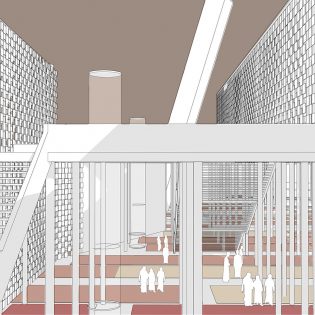Early mosques were the combination of finitude and the capacity to expand: the lands around them had a series of concentric enclosures, the space between these walls (or ziyada) being reserved for the mosque’s future expansion. In most cases, the qibla wall was kept in its original place, while the inhabitable enclosure expanded in the other three directions. In the Great Mosque of Samarra (AD 836), for instance, the space of the ziyada was filled with hypostyle halls. It was not a separate, later addition, but part of the original plan of the mosque.
As it is also known, the liturgical requirements for this sacred space does not necessarily generate the complex choreography of other monotheist places of worship: rather, they are the state of ritual purity of the community, the presence of a leader or imam, and the qibla. These minimal functional requirements make the mosque an abstract type of space that we intend to confirm in our design. Whereas Christian churches are theatrical settings, mosques can be reduced to a few strong elements: the ablution spaces, the qibla, and the minaret.
Therefore, our proposal for the Dubai Creek Mosque international competition relies on these assumptions:
The emphasis on those three fundamental elements, and on a non-figurative monumentality;
The original, abstract, columned hall that epitomizes the greatest mosques of the world, as the temple’s main space, or Main Prayer Hall (or Hypostyle Hall); and
The ziyada as an empty space surrounding the Hall that can absorb future expansions as a built-in device of the plan.
Visualizations: Edit Studio
Text after an essay by Hamed Khosravi















